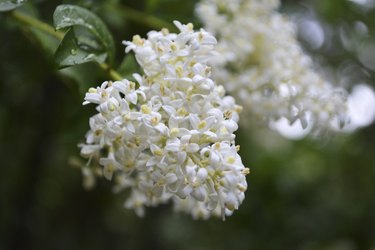
Gardeners in U.S. Department of Agriculture plant hardiness zones 8 through 10 find much to admire in Japanese ligustrum (Ligustrum japonicum). Commonly known as wax-leaf privet for its glossy evergreen foliage, the tough-but-forgiving shrub works equally well sculpted into topiaries, trained as a small tree or grouped as a flowering hedge. In many parts of the country, however, rampantly spreading wax-leaf privets have achieved invasive status. Potential toxicity is another serious drawback to growing them.
Ornamental Features
Video of the Day
Six-inch panicles of tubular blooms line the tips of wax-leaf privet's pale-green stems in late spring and early summer. Although the creamy-white flowers make an eye-catching contrast with the shrub's shiny, deep-green foliage, many people find their yellow pollen irritating. By midsummer, the blooms have yielded to green berries that ripen to black. The fruit hungry birds don't grab may remain on the plants until spring. Seeds from the digested berries often sprout in wild areas, where they crowd out native plants.
Video of the Day
Wax-Leaf Privet Cultivars
Wax-leaf privet's popularity has encouraged plant breeders to introduce cultivars of varying sizes and foliage characteristics. "Howard" (Ligustrum japonicum "Howard") greets the spring with bright-yellow foliage that slowly darkens to green. It's suitable for USDA zones 7 through 10. Small, wavy-margined green leaves with twisting tips distinguish "Recurvifolium" (Ligustrum japonicum "Recurvifolium"), hardy in USDA zones 7 through 11. Small-space gardeners in USDA zones 8 through 10 appreciate slowly growing "Rotundifolium" (Ligustrum japonicum "Rotundifolium"). At maturity, the round-leaved shrub stands just 3 to 5 feet tall with a 2- to 3-foot spread.
Growing Wax-leaf Privet
Wax-leaf shrubs thrive on a minimum of care. They grow well in sun, but may scorch without afternoon shade in hot-summer climates. They accept most acidic or pH-neutral soils except consistently wet ones. They also shrug off urban pollution and salt spray. Crowded or excessively shaded plants may attract whiteflies followed by leaf-blackening sooty mold. Allowing 5 or more feet of space between the shrubs at planting prevents overcrowding. To eradicate the bugs, spray the privets with ready-to-use insecticidal soap until all their surfaces drip. Repeated applications suffocate the flies, and the sooty mold eventually weathers away. Wear washable protective clothing, safety goggles and a respiratory mask and follow the label's directions when handling the soap.
Toxic Terpenoids
Eating wax-leaf privets' berries or leaves may cause terpenoid poisoning. A small amount of the toxin causes stomach discomfort, vomiting or diarrhea. Coordination problems, irregular heartbeat and -- rarely -- death may occur following large doses. Work around the problem by pruning off the spent flowers so they don't develop fruit and supervise young children, pets or livestock while they're near the plants. If you're in the garden-planning stages, consider a non-toxic, non-invasive alternative such as wax myrtle (Morella cerifera). With glossy evergreen leaves, whitish bark and frosted-blue, aromatic fall berries, it's hardy in USDA zones 6 through 11.
- Missouri Botanical Garden: Ligustrum Japonicum
- Invasive Plant Atlas of the MidSouth: Ligustrum Japonicum
- University of Illinois Extension: Poisonous Plants in the Home and Landscape
- Floridata: Ligustrum Japonicum
- Panoramic Farm: "Howard"Japanese Ligustrum
- Monrovia: Curled-Leaf Privet
- Missouri Botanical Garden: Ligustrum Japonicum "Rotundifolium"
- Virginia Cooperative Extension: Privet
- North Carolina State University Extension: Ligustrum Japnoicum
- ASPCA: About Us: Plants and Trees -- Wax-leaf Privet
- University of Florida IFAS Extension Lee County: Morella Cerifera
- Lady Bird Johnson Wildflower Center: Morella Cerifera